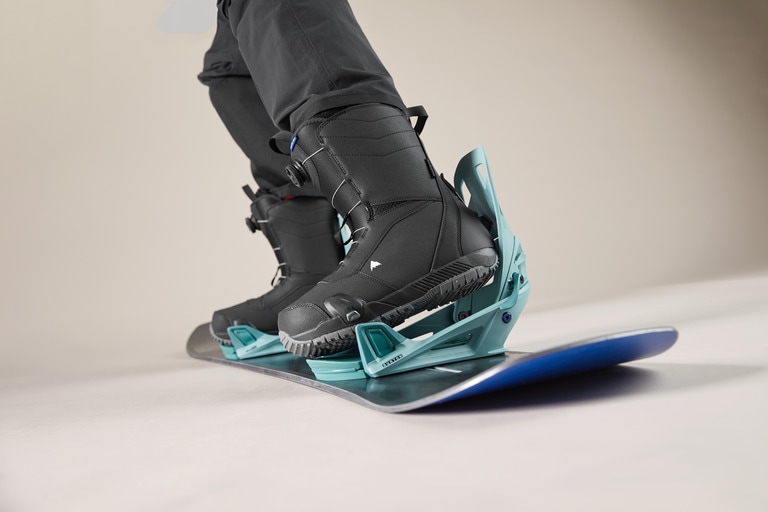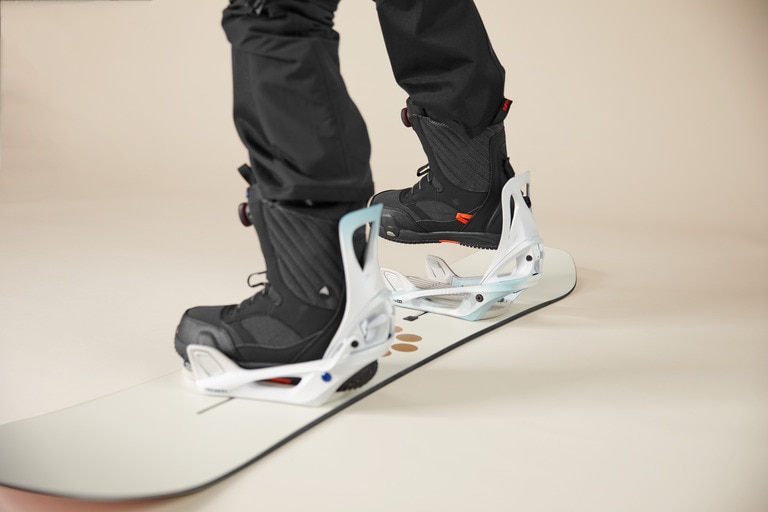You've probably seen step-in snowboard bindings in action at your local ski resort: those boarders who skate off the chairlift, stomp their back foot into a strapless binding and cruise down the run without so much as slowing down to ratchet up. No contorting into hunched-back yoga poses to tighten traditional ratchet straps, no butt freezing in the snow, no ski buddies pestering them to hurry up. They just step in and go. If strapping in is a constant source of woe, step-in bindings may be for you.
This guide will cover who makes step-in bindings, how they work, how to get into them, some pros and cons and answer other questions, including boot and board compatibility.
Unlike traditional snowboard bindings, step-in bindings don't rely on toe and ankle straps to keep your boots attached to the snowboard. Instead, step-in bindings use a locking mechanism (like toe and heel cleats) to connect your boots to the board so you can click in and ride. These bindings are designed to save time, energy and strap-induced frustration on the slopes. We'll dive deeper into the specifics of how the interface works below, but it's important to note that step-in bindings are designed to be used together with specialized step-in boots. You can't use one without the other, as step-in boots include components that lock directly into the step-in binding itself.

While these boot and binding systems seem futuristic, they're actually a blast from the past. Brands like Burton and K2 hawked earlier iterations of step-in bindings in the late 1990s and 2000s and, while hot for a moment, they didn't really catch on. But R&D teams redesigned their respective technologies and ultimately released newer step-in bindings that are currently on the market: Burton with the more well-known and trademarked version, Step On® snowboard bindings and Step On snowboard boots; K2 with its new Clicker X HB system.
Burton, for example, refined its technology and introduced Step On bindings in 2017. Unlike its earlier rendition that joined boot to binding at the sole of the boot, the brand's new Step On system locks from the heel cup and the toe box, providing more leverage and a higher-performance ride. The roots of the newer Step On tech trace back about a decade when the late Jake Burton Carpenter asked the Burton research and development team to design a boot and binding interface that was easy to use, steepened snowboarding's gradual learning curve and would help reduce barriers to entry for the sport.
Throughout the R&D process, Burton realized that the performance applications of the improved system didn't just make the tech attractive for beginners, but for intermediates and even some advanced riders too. The Vermont-based brand has since licensed its Step On technology to snowboard bootmakers DC and Nitro with the hope that Step Ons will become widespread throughout the snowboard world and help more beginners learn the ropes.

Step-in bindings might seem complicated, but the tech is quite simple. While the interface may differ a bit between brands, the idea is the same: Just step into the bindings, apply pressure and lock the boot into place. For example, in the Step On boot/binding system, Step On boots sport cleats on both sides of the toes and one cleat at the heel. Step On bindings have two corresponding hooks at the toes and a corresponding clip at the heel. When the boot presses into the binding, the cleats lock into the toe hooks and heel clip, providing three points of contact and locking the foot in place. To release the boot, simply pop the lever on the heel cup, lift your heel and voilà—you're free to skate onto the lift.
Looking for a more thorough explanation? Here is a step-by-step breakdown of how to get into Burton Step On bindings. Think: Heel, toe and go.
- Place your board on relatively flat ground perpendicular to the fall line so the board doesn't slide away from you.
- Clear any snow off the base of the bindings before stepping in.
- Start with the heel. Press the heel of the boot into the heel clip on the highback of the binding until you hear a click. Press down until you hear a second click. (Tip: Ensure that your pant leg is in the metal clip on the back of your Step On boots to prevent it from getting caught.)
- Next, lock in your boot at the toes. Apply pressure so your toe cleats click into the side toe hooks on your bindings. Wiggle your boot from side to side to make sure both toe cleats are locked.
- You're ready to ride!
Do you need compatible snowboard boots?
Many snowboarders are interested in trying step-in bindings but have perfectly functioning boots at home. Unfortunately, because the boots are half of the locking mechanism, Step On bindings, for example, are solely compatible with Step On boots. As mentioned above, Burton has licensed its Step On technology to other snowboard bootmakers like DC and Nitro in recent years, so those brands also offer Step On boots to fit Step On-specific bindings. K2 is another brand with step-in bindings, called Clicker X HB, which only work with Clicker X HB boots.
In other words: Yes, you need compatible boots.
What are some pros of step-in bindings?
- Convenience: The biggest reason step-in bindings are gaining popularity is that snowboarders can avoid strapping in at the top of runs. That means no more ice-cold keister, a lot less bending over and more time to ride. Practiced users can stomp into step-in bindings extremely quickly, allowing them to maximize time spent riding as opposed to fiddling with bindings.
- Impressive response: Because the toe and heel of the boot are directly connected to the binding, riders report that edge-to-edge response is as immediate as it gets. This connectivity is also helpful when generating pop for ollies.
What are some cons of step-in bindings?
- Too "locked in": Some strap purists appreciate the wiggle room of traditional bindings, especially when tweaking grabs, throwing tricks or leaning into butters and presses, and they report losing that playfulness with step-in bindings. There's also been mention of uncomfortable pressure points due to the stiffer tongue construction of the boots.
- Compatibility: Because of the tech at play and the need to match boot to binding, there are fewer boot options on the market—at least for now.
- Can take some getting used to: For some, riding step-in bindings is a natural transition. For others, it can take some getting used to. Some riders report that binding entry and exit on steeper slopes or in deep powder can be more challenging than with traditional strap bindings.
Should beginners get step-in bindings?
Beginners may love step-in bindings because of the ease of entry and exit. Beginners often spend fewer days per year on the slopes, meaning every minute on the hill is precious. And as we mentioned earlier, less time spent messing with bindings means more time turning and learning.
While Step Ons were originally conceived for beginners, be sure to do your research. There are multiple Step On options on the market for both boots and bindings. Beginners should gravitate toward the softer, more affordable options, as they'll be easier to flex, drive and command.
Should advanced riders get step-in bindings?
If you're an advanced rider, you may prefer the ride feel and play provided by traditional bindings. That said, improvements in Step On binding tech and boot comfort might make now the time to give the Step On system a try, particularly if bending over to strap in is a constant thorn in your ride. If you're a parent trying to keep up with the groms, regularly ride with skiers or have limited time on the slopes, even more reason to dip your toes in Step On life.
Can you put Step On bindings on any snowboard?
Re:Flex Step On Bindings are compatible with boards that sport traditional 4 x 4 hole patterns as well as the Burton Channel system. EST Step Ons are solely compatible with boards that use the Channel system.
And if you're a skeptic? No worries, traditional strap-in bindings aren't going anywhere. At least not yet.
